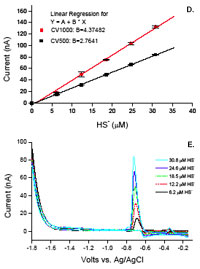 Research
Research
Sensors and Instrumentation Development
In situ and longer term sensing of the environment has been a rapidly growing priority, especially within the field of marine biogeochemistry. Our work focuses on the central goal of advancing the recently developed analytical technique of in situ voltammetry to gain the capability for widespread integration into seafloor observatory networks. Traditional methods of determining speciation and concentration of analytes in seawater, porewater, and sediments have required either the retrieval of sediment cores or porewater samples for analysis, isolating the sample from the environment and producing temporally discrete samples.
 In recent years, in situ voltammetry has been successfully used to collect redox analyte measurements in coastal bays, salt-marsh and mangrove sediments, the Black Sea water column, and hydrothermal vents, among other environments. In addition to continuing to improve and use this method for answering discrete biogeochemical questions (see other targeted specific research projects) we are improving the instrumentation for incorporating additional sensors and for making extended deployments in a variety of environments.
In recent years, in situ voltammetry has been successfully used to collect redox analyte measurements in coastal bays, salt-marsh and mangrove sediments, the Black Sea water column, and hydrothermal vents, among other environments. In addition to continuing to improve and use this method for answering discrete biogeochemical questions (see other targeted specific research projects) we are improving the instrumentation for incorporating additional sensors and for making extended deployments in a variety of environments.
Coastal Observing - new developments and telemetry testing
We are currently testing a new platform for inexpensive, custom,multi-parameter data loggers that utilize nearshore RF telemetry. Look for this space to become much more exciting in the coming weeks as we add sensor capabilities and additional nodes to monitor biogeochemical parameters important to He`eia watershed, Kaneohe Bay, Oahu.




